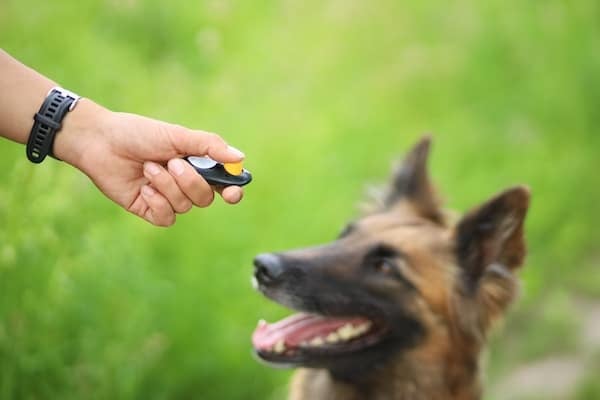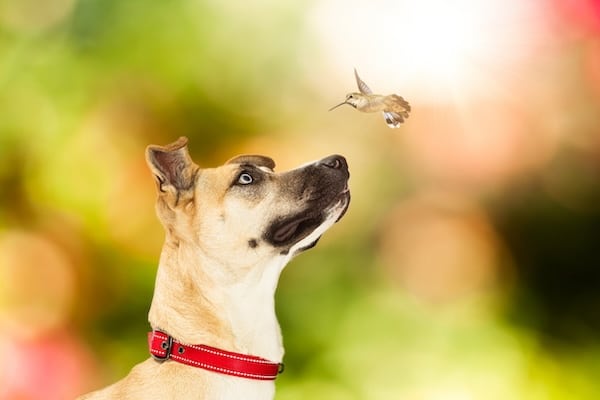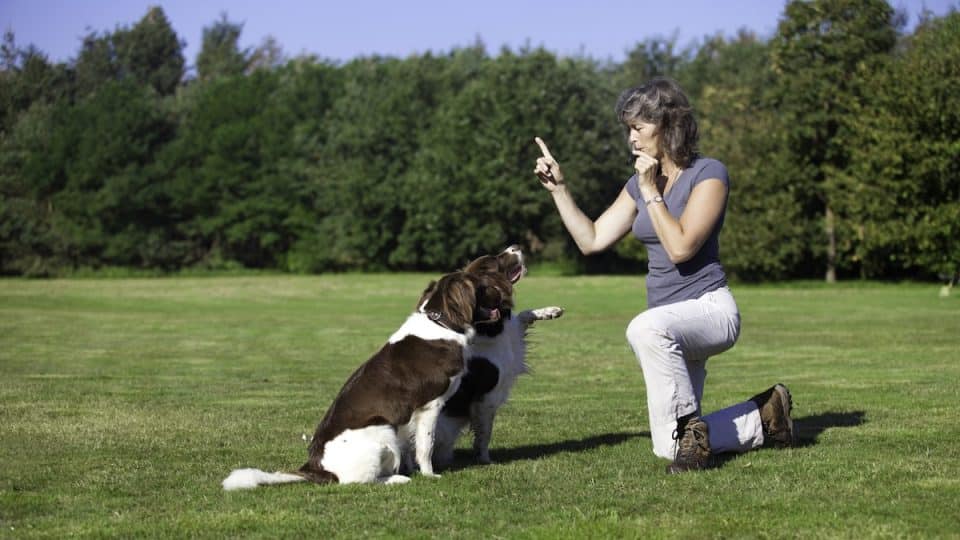- This post contains affiliate links. Read more here.
- Not a substitute for professional veterinary help.
Dogs aren’t just masters of smell—their hearing abilities are equally remarkable. Dogs can detect frequencies up to 65,000 Hz, far beyond the human limit of 20,000 Hz. Many dogs are naturally drawn to high-pitched noises, partly because they’re sensitive to them and partly because they resemble the sounds made by prey.
Of course, not every dog has the same sound preferences. A dog’s individual experiences play a major role in how they react to different sounds. For example, a dog who eats wet food might leap up in excitement at the sound of a can opening, while a pup who eats dry food won’t take any notice.
There are, however, sounds that most dogs are instinctively drawn to. We’ve put together a list and collected expert insights on how you can use these sounds to strengthen your bond with your dog and meet your training goals.
10 Sounds Dogs Love
Sounds that attract dogs are often high-pitched and appeal to basic canine instincts. Here are some noises that lots of dogs like to hear.
Kissy sounds
Have you ever wondered why kissy sounds instantly grab your pup’s attention? The puckering noise works because it’s distinct, breaking through everyday noise. And since affection and play typically follow, dogs learn to associate the sound with positive interactions. Some trainers even encourage using kissy sounds as a positive interrupter to redirect dogs from unwanted behavior (like barking or digging).
Baby voice
Does your pup light up when you speak to them in a “baby voice”? Dogs pick up on the upbeat inflection, and studies show they’re more eager to interact when spoken to in a cheerful manner. Dogs also get excited when humans make these sounds because they’re often associated with a positive experience.
“Most dogs learn from a young age that when humans make high-pitched noises, something good follows, such as food or affection,” explains Annie-Mae Levy, a certified dog trainer at Woofz.
Squeaks
Squeaks are high-pitched sounds that drive many dogs wild because they mimic the cries of prey. Squeaks also often signal playtime and social interaction with their human. Squeaky toys are a great addition to your dog’s collection to help prevent boredom and keep them stimulated.
Clickers
On their own, clickers aren’t particularly exciting. But with clicker training, your dog will quickly learn to associate the sound with rewards.
The distinct “click” has a few advantages. It’s neutral and consistent, and it allows for precise timing when marking desirable behaviors. This accuracy makes it easier for dogs to understand which exact behaviors their pet parent is rewarding—and repeat them in the future.

Veronika Vackova via iStock
Crinkling
A lot of dogs like crinkling sounds, perhaps because they resemble the rustling sounds of small animals. It’s no wonder crinkle toys are particularly appealing. Some dogs may also associate the sound with food or treat bags.
Whistling
The loud and distinct sound of whistling attracts your dog’s attention by cutting through the noise of busy environments. Many pet parents train a whistle as a recall cue, connecting the sound with a positive reward, like treats or play.
Some even use a whistle for other cues, with short, long, or multiple bursts conveying different cues like “sit,” “down,” or “stay.” A whistle can also take the place of a clicker, marking the exact moment your dog performs the right behavior.
There are also commercial dog training whistles, which produce high-pitched tones undetectable to humans. The sound of these carries farther than clickers, making them especially effective for training herding or hunting dogs.
Laughing
Dogs have an incredible ability to understand human emotions, especially when paired with positive or negative outcomes. If the sound of your laughter makes your dog happy, then there’s likely a long history behind it. You can feel good knowing they’ve interpreted the sounds of your chuckles and joyful body language to signal fun!
Music
Evidence shows that calm music can encourage dogs to settle and relax. These soothing melodies can lower stress hormones and boost the release of feel-good chemicals like serotonin and dopamine, points out Susan Nilson, a canine behavior and training consultant and founder of The Cat and Dog House.
Conversely, loud music with heavy bass, like rock or heavy metal, tends to create anxiety and discomfort for dogs. So if you want to keep your dog chill, consider playing soft tunes to create a peaceful vibe.
White noise
For many dogs, white noise offers comfort and security. It effectively masks disruptive sounds, such as honking cars or thunderstorms, which can trigger anxiety in pets.
Playing white noise—via noise machines, apps, or smart devices—when you leave your dog alone may also help ease separation anxiety. To maximize the calming effects, combine white noise with proper training and, if necessary, consult a professional behaviorist or trainer.
Birds and nature sounds
Sounds from nature attract dogs by tapping into their primal instincts. The gentle chirping of birds or the rustling of leaves can create an atmosphere that many dogs find comforting. Try incorporating nature sounds into your daily routine, using them as a calming backdrop during quiet moments or when introducing new training concepts.

adogslifephoto via iStock
5 Sounds That Make a Dog Go Wild
Certain sounds elicit more intense reactions in dogs, making them bark, pace, or hide. Loud noises like horns, alarms, sirens, garbage trucks, thunder, or fireworks are more intense to their sensitive ears and can be overwhelming and scary for many dogs.
Other noises make dogs go wild out of excitement. For instance, if your dog equates a person talking outside or another dog barking as social time, they’re likely to get amped.
Understanding these different triggers—and how your dog responds to them—can help you create a safe environment for your pup.
Car horns
Dogs are naturally alert to unexpected noises, and the abruptness of a horn can be startling. To help your dog feel at ease, consider training techniques that desensitize them to the sound. For example, play recordings of car horns at a lower volume while giving your dog a relaxing activity, like a lick mat or puzzle toy, to help them adjust gradually.
Doorbells
Doorbells can trigger a mixed bag of emotions. For some dogs, Nilson explains, the sound signals the excitement of visitors, while for others, it may spark a defensive response. If doorbells cause your dog to bark, consider switching to a doorbell with softer chimes. You can also rewire your dog’s response by ringing the doorbell and offering treats or another reward they love.
Shakers
Shaker cans contain coins or pebbles that create a loud noise when rattled and are sometimes used for training. While they can interrupt unwanted behaviors, they risk causing fear and anxiety in dogs. To avoid the fallout of aversive tactics, use fear-free methods to redirect your dog—like making a kissy noise instead.
Alarms and sirens
Loud, sudden sounds like car alarms, smoke detectors, or sirens can be jarring for dogs. To help your dog cope, provide a safe space for them to retreat when they get scared. You can also play soothing music or white noise to drown out distressing sounds.
Garbage trucks
For many dogs, the garbage truck is the ultimate menace. The combination of loud engines, screeching brakes, and high-pitched beeping can send dogs into a barking frenzy. To help your pup handle collection day, provide plenty of reassurance. Additionally, consider setting up a safe space for your dog or distracting them with a stuffed KONG.
How Dogs React to Sounds Depends on Socialization
Socialization and past experiences deeply influence a dog’s reaction to sounds. As Levy explains, every dog builds associations with different sounds based on what they’ve encountered throughout their lives.
For instance, a dog raised in a loving home may eagerly anticipate the crinkle of a treat bag. However, a fearful rescue might associate that same sound with humans trying to initiate contact—something they may not necessarily want.
Recognizing these different responses helps pet parents cultivate a supportive environment, as Nilson points out. “When dog parents have a better understanding of the sounds their dog likes, they can use their preferences to build trust and make training more effective,” she adds.



